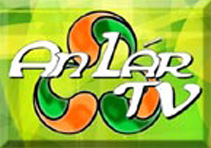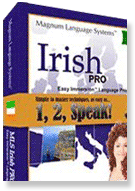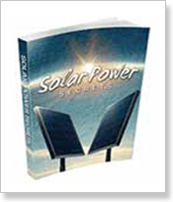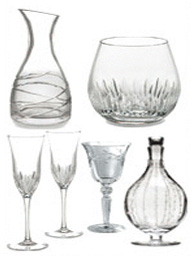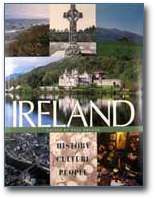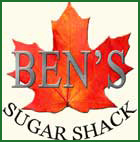Favorite Ireland Books
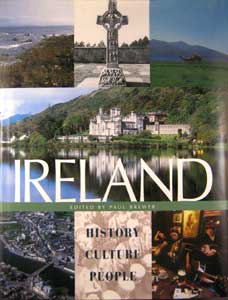 |
Ireland: History, Culture, People edited by Paul Brewer
This book is filled with general information about Ireland. There are seven chapters regarding different stages of Irish history, starting with the first traces of human settlement circa 7000 B.C., when it appeared that the inhabitants were hunters and fisherman. By 4000 B.C., the New Stone Age Neolithic farmers had developed an ability to cultivate land. They also built a variety of megalithic (large stone) tombs, such as the passage grave at Newgrange, County Meath. County Meath is known as "The Royal County", where the Kings of Ireland were seated, the Hill of Tara is located, and the Book of Kells was housed for many years.
Many people think of the ancient Irish as the Celts (pronounced Kelts) but their arrival was during the latter part of the first millennium B.C., when Ireland was invaded by "immigrant bullies" from other countries throughout Europe. Although pre-Celtic languages can be traced, the Celtic language was formed from a combination of other early languages. The Irish-Gaelic language prevailed but Gaelic dialects were as individual as America's Southern drawl compared to a Bostonian dialect. There is also information about each of the four Provinces; Connacht, Leinster, Munster and Ulster, as well as each County.
The clans and families of Ireland are covered, including a brief Heraldic description and Coats of Arms pictures. The final chapter is about the Irish who went abroad to Canada, Australia, New Zealand, South America, Great Britain and the United States. This is not only about people who came during the Irish Potato Famine but about those who immigrated during Colonial and Revolutionary America, and post-Famine Ireland.
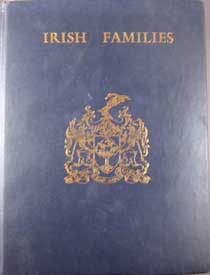 |
Irish Families: Their Names, Arms, and Origins by Edward MacLysaght
This book includes a mountain of information regarding the true origins of Irish surnames (Gaelic Clan names), the relevance of the distortion of surnames by the English, the surname changes made by the English, and the heraldic matters associated with the Coats of Arms.
Some names that are now considered Irish belonged to transplanted families from other countries in Europe; i.e., Burke and Fitzgerald are originally Norman. Ireland was invaded by many countries over the centuries but the Kings and Queens of England were mainly responsible for the distortion of true Irish names, as well as Irish words. The Gaelic language consists of a different alphabet, grammar and pronunciation, and the closest comparison is it's similarity to Latin. Between 1200 - 1600, the English forbade the use of the Gaelic language, and they Anglicized the names and words, spelling and pronouncing them phonetically as to how they thought the words sounded.
There is a chapter on the use of Mac and O in Irish names. No Irish names originally started with a Mac or an O. They were used to differentiate between a man and his son, with a Mac, or his grandson, with an O. Today many Irish families have dropped these prefixes.
Each Irish name is accompanied by a page or two of it's origin and in what part of Ireland it is most prevalent. There are pictorial pages of Coats of Arms for each family as well as brief text describing each shield and the crest, if present.
Note: This is Terry's favorite book of all. He started reading it in a local library but was unable to take it out as it is categorized as a reference book. It soon became my favorite, as well, because I found the information fascinating. In 2001, my sister bought a copy of this book on eBay and gave it to Terry as a Christmas gift. It was very much appreciated.
One thing that Terry likes about this book is the fold-out ancestral map. It shows where in Ireland the largest concentration of Irish family names are most prevalent. You can purchase your own Ancestral Map of Ireland like this one.
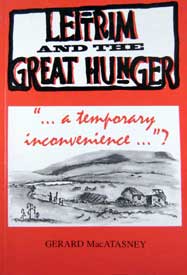 |
Leitrim and the Great Hunger: "...a temporary inconvenience.."? by Gerard MacAtasney
This book is one of the saddest books we have read. It is about County Leitrim's experience during An Gorta Mor, or the Irish Potato Famine 1845 - 1850. Even though we, like many people, believed that the "Great Famine" was the only one, we were sadly mistaken. There was a succession of many famines prior to the most famous one, which was the worst. Originally eaten by the aristocracy, at this time in Irish history, the potato was the main source of nutrition for the poor people of Ireland. The blight caused the potatoes to become inedible and, without crops to sell, they had no money to pay rent or to buy food.
Most of the Irish people were poor, equivalent to the lowly serfs from the medieval feudal classes of society. The English were in power, and all of the Earls of the counties were pretty much the "Masters" of the Irish "Slaves". If the tenant farmers could not produce crops from the land they tended, they would be sent to the workhouses in exchange for public assistance. Even though these conditions were cruel, the landlords were trying to keep the people alive.
The Earls established Poor Law Unions to cover certain areas of the counties. This book contains lists of the Parishes, Baronies and Townlands, as well as lists of the inmates in the workhouses, including the aged, the sick and some children. There are lists of crimes (mostly stealing food) and punishments, including whippings. It states how many people died and what their names were. There are lists of soup kitchens and what the daily meal consisted of, which was mostly gruel. Lord Leitrim would conduct meetings about the Famine at his home, while he and his underlings dined on roast beef or mutton. After reading this book, along with other information gathered about the Famine, we are very aware of how lucky we are.
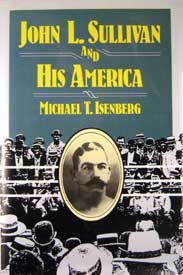 |
Even though this book contains information that may not be very pretty, Terry is proud to be a distant relative of John L. Sullivan, if only for his sporting achievements. Adelaide Mary Hennessy, Terry's maternal grandmother, whose mother's maiden name was Sullivan, was a distant cousin to John L. Sullivan. When Terry was growing up, he remembers his grandmother, his mother and other family members talking about "the great John L.". Sometime prior to his death in 1918, he would stop by, driving his large convertible touring car, and bring Adelaide and the family for a ride.
This book is a candid biography of John L. Sullivan, the "Boston Strong Boy", the Heavyweight Championship Boxer from 1882 to 1892. John was an Irish American, whose parents, Mike Sullivan and Catherine Kelly Sullivan, had immigrated to Boston. He was known as a drunkard, a womanizer, an abuser and a braggart. He was a bar room brawler and was famous for saying that he would take on all comers.
The people of Ireland were proud that he was the first well-known man of Irish descent. Not only was he a famous Irishman, in his heyday, he was the most well-known person in the entire world. Even though his reputation preceded him, people were willing to accept him with his faults. His celebrity in the boxing and entertainment world made up for some of the scandals.
He was married twice. He and his first wife, Annie Bates Bailey, a young widow, lived together, unwed, for about a year before they married in 1883. In 1884 John L., Jr., their only child, was born. Annie left the marriage after twelve years of abuse, and in 1908, John divorced her, contrary to his religious beliefs. His second wife, Katherine Harkins, who was once his sweetheart, married him in 1910, after he was divorced and had stopped drinking. One of his best friends was "Diamond Jim" Brady, a very wealthy gentleman of his day. John L. earned a vast amount of money during his career as a boxer and, later as an actor, but ended his life almost penniless. He died a widower in 1918 and was buried in Mount Calvary Cemetery in Roslindale, Massachusetts.
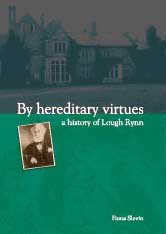 |
By Hereditary Virtue: a History of Lough Rynn by Fiona Slevin
This book is filled with information that has been gathered from actual documents in libraries, colleges and other Irish institutions. Starting with the MacRaghnaill Clan, the earliest "Lords" of Rynn, it mentions the ruins of the original MacRaghnaill Castle and medieval feuding with the O'Rourke and O'Riley Clans. It's contents are factual and contradict some of the rumors and old tales about the Earls of Leitrim. A major part of the book is devoted to the Third Earl of Leitrim, William Sydney Clements. His reputation was that of a tyrant but he was also the catalyst for many improvements to his estate, County Leitrim, and for it's residents.
Note: Fiona Slevin is the daughter of Tim and Tina Slevin of Mohill, County Leitrim, Ireland. Her two books were extremely interesting to Terry and me because of our close relationship to Mohill and the MacRaghnaill (Reynolds) Clan. It was particularly informative, considering all of the tales we had heard about William Clements, the Third Earl of Leitrim, and that many of them were either falsehoods or incomplete.
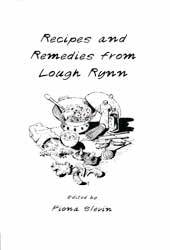 |
Recipes and Remedies from Lough Rynn by Fiona Slevin
This book includes authentic writings by Lord Leitrim's housekeeper from the 1800's. Some of the remedies show diseases and ailments that 19th century Irish people suffered from, including cancer. One remedy for cancer of the lips and gums says to boil down olive oil to the consistency of ointment and apply it to the affected area. It says that it would be cured in 14 days and nothing else was needed.
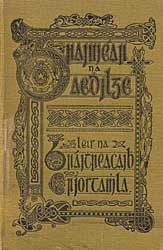 |
Irish Grammar by The Christian Brothers
This is my favorite Irish book that I purchased at a used bookstore about eight years ago. I wanted to learn how to speak Irish Gaelic but it was harder than I thought. I did learn something but not enough to speak it.
The Irish alphabet contains eighteen letters, five of which are vowels and the remaining thirteen are consonants. The vowels are a, e, i, o, u; and the consonants are b, c, d, f, g, h, l, m, n, p, r. s, t. Some of the letters look like English letters but several do not. Some letters also have accents and dots which refer to the pronunciation.
The first chapter deals with the spelling and pronunciation of the vowels and consonants. There are broad vowels, slender vowels, long vowels and short vowels. Then they have 'digraphs', which are two vowels combined, called 'diphthongs', and 'trigraphs'; three vowels combined, called 'triphthongs', of which there are only six. The consonants are either liquid or mute, broad or slender, depending on the vowel either preceding it or following it. They also have combined consonants and their pronunciation.
This book gives phonetic examples of how we would pronounce the letters using the sounds of the English language. They explain Aspiration, which is breathing; Eclipsis, which is used when two consonants are combined and one is silent. It explains exactly where in your mouth to place your tongue to get the correct sound. Insertion and Syncopation are difficult to explain, but I believe they occur when changing gender. I think that the first chapter is the most important because you have to know how to pronounce the letters for the rest of the book to make any sense.
 |
Even though I didn't really learn how to speak the Irish language, I use this book as a reference to look up Irish words. I would still like to learn Irish Gaelic, so maybe some day I will.
I had mentioned to Arnold Fitzpatrick that I had tried to teach myself Gaelic. He was a new friend that we met in November 2006. To read the story about Arnold and the Gaelic lesson he gave us, click here.
Disclaimer: LittleShamrocks.com is an affiliate website that receives commissions from sales of the products listed. We have purchased and sampled many, but not all, of the products on these pages.
© Copyright LittleShamrocks.com. All Rights Reserved.



